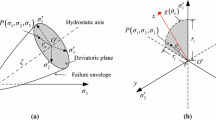Abstract
Based on the test data of frictional materials and previous research achievements in this field, a generalized non-linear strength theory (GNST) is proposed. It describes non-linear strength properties on the π-plane and the meridian plane using a unified formula, and it includes almost all the present non-linear strength theories, which can be used in just one material. The shape of failure function of the GNST is a smooth curve between the SMP criterion and the Mises criterion on the π-plane, and an exponential curve on the meridian plane. Through the transformed stress space based on the GNST, the combination of the GNST and various constitutive models using p and q as stress parameters can be realized simply and rationally in three-dimensional stress state.
Similar content being viewed by others
References
Yu, M. H., Song, L. Y., Generalization of twin shear stress criterion, Journal of Xi’an Jiaotong University (in Chinese), 1983, 17(3): 65–69.
Yu, M. H., He, L. N., Song, L. Y., Twin shear stress strength theory and its generalization, Science in China (in Chinese), Ser. A, 1985, 28(12): 1113–1120.
Yu, M. H., Twin Shear Stress Strength Theory and Its Application (in Chinese), Beijing: Science Press, 1998, 60–63.
Yu, M. H., He, L. N., A new model and theory on yield and failure of materials under the complex stress state, Mechanical Behavior of Materials-6, London: Pergamon Press, 1991, 3: 841–846.
Yu, M. H., He, L. N., Liu C. Y., Generalized twin shear stress criterion and its generalization, Chinese Science Bulletin (in Chinese), 1992, 37(2): 182–185.
Yu, M. H., Unified strength theory for geomaterials and its applications, Chinese Journal of Geotechnical Engineering (in Chinese), 1994, 16(2): 1–10.
Matsuoka, H., Nakai, T., Stress deformation and strength characteristics of soil under three different principal stresses, Proc. of JSCE, 1974, 232: 59–70.
Lade, P. V., Duncan, J. M., Elastoplastic stress-strain theory for cohesionless soil, J. Geotech. Eng. Div., ASCE, 1975, 101(10): 1037–1053.
Chowdhury, E. Q., Nakai, T., Consequences of the ij -concept and a new modeling approach, Computers and Geotechnics, 1998, 23: 131–164.
Pivonka, P., Lackner, R., Mang, H. A., Shapes of loading surfaces of concrete models and their influence on the peak load and failure mode in structural analyses, Int. J. Eng. Sci., 2003, 41: 1649–1665.
Aubertin, A., Li, L., Simon, R. A., Multiaxial stress criterion for short-and long-term strength of isotropic rock media, Int. J. Rock Mech. Min. Sci., 2000, 37(8): 1169–1193.
Yao, Y. P., Sun, D. A., Application of Lade’s criterion to Cam-clay model, ASCE, J. Engrg. Mech., 2000, 126(1): 112–119.
Yao, Y. P., Sun, D. A., Application of Lade’s criterion to Cam-clay model (Closure), ASCE, J. Engrg. Mech., 2001, 127(6): 631–633.
Matsuoka, H., Yao, Y. P., Sun, D. A., The Cam-clay models revised by the SMP criterion, Soils and Foundations, 1999, 39(1): 81–95.
Yao, Y. P., Luo, T., New transformed stress space and its application, Proc. of 7th Numerical Calculation and Analysis on Geomechanics (in Chinese), Dalian: Dalian University of Technology Press, 2001, 16–22.
Roscoe, K. H., Schofield, A. N., Thurairajah, A., Yielding of clay in states wetter than critical, Geotechnique, 1963, 13(3): 211–240.
Sheng, Z. J., Reasonable expression of elastoplastic stress-strain relationship of soils, Chinese Journal of Geotechnical Engineering (in Chinese), 1980, 2(2): 11–19.
Jiang, J. J., Non-linear Finite Element Analysis on Reinforced Concrete Structure (in Chinese), Xi’an: Shanxi Science and Technology Press, 1994, 24–34.
Chen, W. F., Constitutive Equations for Engineering Materials, Vol. 1 (translated by Yu, T. Q. et al.) (in Chinese), Wuhan: Huazhong University of Science and Technology Press, 2001, 199–218.
Lee, K. L., Seed, H. B., Drained strength characteristics of sands, Journal of the Soil Mechanics and Foundations Division, ASCE, 1967, 93(6): 117–141.
Yu, M. H., Zan, Y. W., Zhao, J., A unified strength criterion for rock material, Int. J. Rock Mech. Min. Sci., 2002, 39: 975–989.
Launay, P., Gachon, H., Strain and ultimate strength of concrete under triaxial stresses, Special Publication, SP-34, ACI, 1970, 1: 269–282.
Lade, P. V., Inel, S., Rotational kinematics hardening model for sand: Part I concept of rotating yield and plastic potential surfaces, Computers and Geotechnics, 1997, 21(3): 183–216.
Guo, Z. H., Strength and Deformation of Concrete (in Chinese), Beijing: Tsinghua University Press, 1997, 156–156.
Willam, K. J., Warnke, E. P., Constitutive model for the triaxial behavior of concrete, International Association for Bridge and Structural Engineering, Seminar on Concrete Structure Subjected to Triaxial Stresses, Paper III-1 Bergamo, Italy, IABSE Proceedings, 1975, 19: 1–30.
Liu, M. C., Gao, Y. F., Liu, H. L. et al., Large scale triaxial test study on deformation and strength characteristics of rockfill materials, Chinese Journal of Rock Mechanics and Engineering (in Chinese), 2003, 22(7): 1104–1111.
Lade, P. V., Musante, H. M., Three-dimensional behavior of remolded clay, J. Geotech Engrg. Div., ASCE, 1978, 104(2): 193–209.
Lade, P. V., Stress-strain theory for normally consolidated clay, Proc. 3rd Int. Conf. Numer. Methods in Geomechanics, Aachen, ed., Balkema, 1979, 3: 1337–1352.
Author information
Authors and Affiliations
Corresponding author
Rights and permissions
About this article
Cite this article
Yao, Y., Lu, D., Zhou, A. et al. Generalized non-linear strength theory and transformed stress space. Sci. China Ser. E-Technol. Sci. 47, 691–709 (2004). https://doi.org/10.1360/04ye0199
Received:
Issue Date:
DOI: https://doi.org/10.1360/04ye0199




